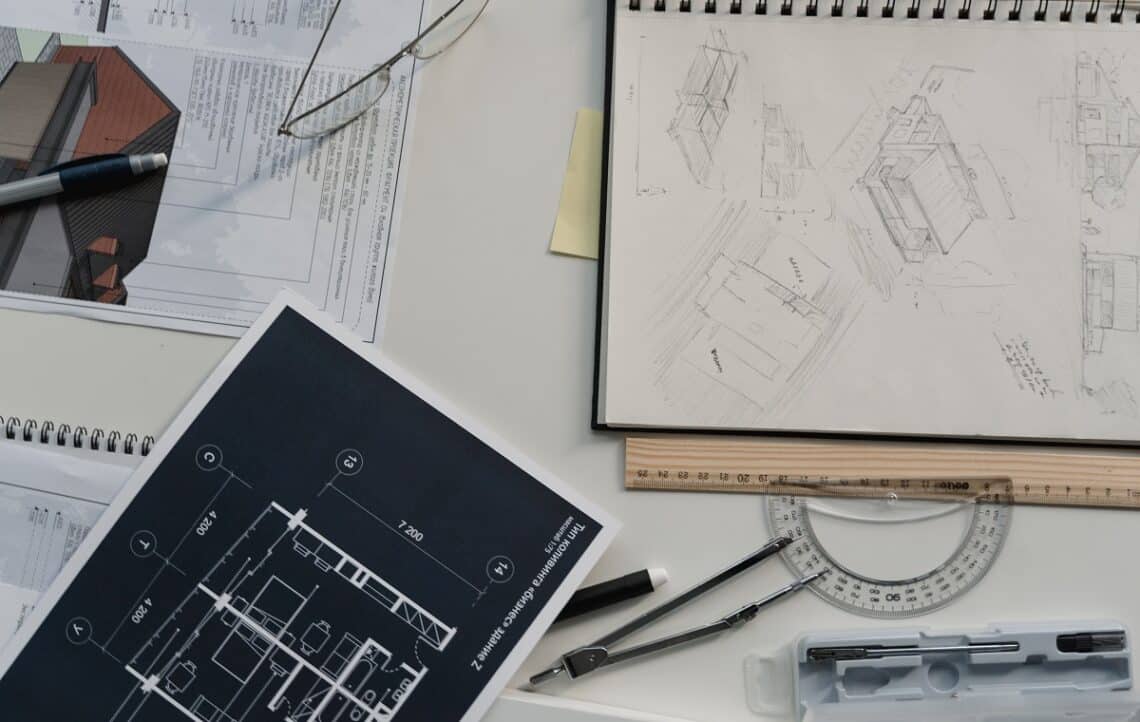Just like a building, a software system needs a well-made architectural diagram.
Quite often, software engineers have a hard time making others understand their vision. This problem stems from the lack of proper technological communication, as everyone might not have the same knowledge.
Along with writing good code, it’s crucial to come up with a proper software architecture diagram as a visual representation of the planning. However, most coders are still unaware of the right way to represent a software system through diagrams. And, seldom do they know that there are several types of architectural diagrams to simplify the task.
To ease you into the idea of this functional application of diagrams, we have come up with this informational guide. We will take you through the journey of how these diagrams can make your programming work even more seamless.
So, without further delay, let’s get started!

What Is Architecture?
When we think about the word “architecture,” the first thing that comes to our mind is a building. But, rather than the physical entity, architecture is about planning and plotting how to create the building. This also includes the amalgamation of different design aspects and how everything would come together to form a cohesive structure.
Similarly, in “software architecture,” there are different entities that are integral to software. And, to make a successful program, you would need to define the relationships present between these entities. Along with that, architecture also helps to understand the behavior of these entities when it has to interact with the broader environment.
Defining the entities, their relationships, as well as the several decision-making aspects, can seem confusing to someone who doesn’t work with software. Using an architecture diagram helps ease down the communication barriers to give them a logical view of the overall plan.
What Are Architecture Diagrams?
You can think about the architectural diagrams as blueprints. The roadmap present in the diagrams helps others understand the system and shows them a way to recreate it.
Through the different components of the diagram, such as symbols, you can portray the desired relationships or boundaries set in the program. Moreover, there are various types of architectural diagrams that you can utilize according to the audience.
Creating architectural diagrams can help mitigate the issues that might be present in the software design. Also, in the diagrams, you need to pay attention to the outcome for everyone, including the user and even the marketer.
Benefits Of Architecture Diagrams
As more people get into using architecture diagrams, you are bound to think if it’s really that beneficial. One of the foremost reasons behind this is definitely the hindrance of learning to use a new medium to express something like software visually. So, let’s have a look at some of the benefits of using software architecture diagrams.
1. Better Understanding
Even after coming up with a whole software project and planning out the structure, there will be times when you are left clueless. To avoid such situations, you can use these architecture diagrams in place of mind maps. And, as there are various models of representing a program, it won’t be hard to find one that suits your needs.
Moreover, if you are working in a group environment, utilizing these diagrams makes the design process easier as the visualization speaks for itself. And, as scalability has turned out to be an essential prerequisite for software, using diagrams brings the program to life and shows the practical considerations.
2. Better Communication
Anyone working in designing software knows that it’s never a one-person job. Apart from other key team members, some stakeholders or clients may not be well acquainted with all the technicalities of the software system. In such situations, the architecture diagram works as a bridge for better communication.
Using multiple diagrams, you can make them understand your vision by showing things like the internal and external systems as well as software components. The visualizations ease out the complexities present in communicating technical ideas or programs.
3. Better Collaboration By Gathering Inputs
Building software may seem like an easy job, but any project has the probability of failure if it isn’t tested for problems that may hold back the whole process. Collaboration helps to pool in more ideas and also find out solutions to fix a problem right at the start.
Hence, to create more potential for a program, you can use the software architecture diagrams to make it more understandable for all your colleagues. These diagrams mainly help to call in collaborations from those who are involved with non-technical aspects of designing a software system.
Components Of A Well-Made Architecture Diagram
There are different types of architecture diagrams that are available for use. Shouldn’t it just make things more confusing? No, they don’t, as every program is diverse. Having said that, some people tend to overcomplicate or oversimplify the diagrams. So, let’s have a look at the key features of a well-made diagram.
1. Showcase System Interactions
When you are designing the software architecture diagram, make sure to include the interactions that take place between the various components. The diagram can be pretty hard to read if these interactions aren’t included, as it will lack the logical view of data flow. You don’t need anything fancy to denote these relationships, as simple shapes and lines do the trick.
2. Include Relevant Notes And Annotations
Aren’t the diagrams supposed to help in visualizing? Yes, they are, but that’s not all. Along with a better understanding, you can use annotations and notes to highlight the crucial components of a program.
As some people gravitate towards reading materials, including notes makes the diagram more accessible. You can also include annotations and notes on instances when a new idea has been introduced to the program.

Types Of Architecture Diagrams
One of the things to know about architecture diagrams is that there are too many of them. People use different forms of classification; while some stick to the basic definitions, others go deeper to feature the usage. Rather than making it overly complicated, we have compiled various types of architecture diagrams to make them easier for you to understand.
You must be questioning the reason for having the variants. Though it may seem redundant, the varied types of architecture diagrams work as graphical representations of different perspectives. And, the pattern of the diagram may even change based on the target audience. So, let’s have a look at some of the most prominent software architecture diagrams.
1. Flow Architecture Diagram
If you’re looking for a simple yet effective way to visually describe your program or coding, then the flow diagram can be the best option. You can use basic shapes to portray the various components and lines to show the flow or relationship between them.
The flow diagram is great for easy understanding, and you can even make it quickly on a piece of paper. It’s considered a medium to a high-level diagram, and the audience is mainly those acquainted with technology and jargon related to software. This form of diagram is also useful to present the intended business process of a program.
2. Service Architecture Diagram
This architecture diagram style is mainly used to depict the distinct services being used in a program. The service diagram is considered to be a high-level diagram, and its intended audience is people well-versed in IT and network programming.
Others may find it a little daunting because this diagram doesn’t depict the flow or relationship between various components. However, this diagram is excellent for showing the key elements of the program.
A common application of the service diagram is to show the internal vs. external services of software. While creating this diagram, make sure to provide details about the microservices involved in the program ecosystem. And, it’s always better to give notes and labels to each service component to avoid confusion.
3. Persona Architecture Diagram
Creating a persona is used by software engineers to show the business flow of the program. This diagram provides a chronological view of how you should execute the program to get the intended results. You may have understood that this diagram is mainly meant for the business layer who are more focused on the execution of a program rather than the technological aspects.
If you are working in a team, using the person diagram can also help assign each person’s task in handling the software. Because of the detailed view, this diagram is considered to be a lower-level diagram. So, you should never curtail on the details and notes as they provide a clear perception of the workflow. Also, make sure to label the different elements properly.
Interestingly, new software developers also like to use the persona diagram as the evolution roadmap of the software.
4. Infrastructure Architecture Diagram
This architecture diagram aims to see the infrastructure or overall view of the software along with the ways in which all the elements have been implemented. It’s considered to be a low-level diagram, and you should include all components present in the program for better communication.
The intended audience of this diagram can vary, but it’s usually the technically involved people, as it contains a lot of details. Developers have been known to use the infrastructure diagram to map out the work of microservices in a program. But, the diagram can very well be shown to a client to make them understand your work plan.
A unique thing about the infrastructure diagram is that, along with giving a bird’s eye view of the program, it also details each component and movement. Hence, even though it may take you many hours to finish this diagram, don’t skip out on any element just because it’s less significant.

5. Developer Architecture Diagram
The developer diagram is a peek into the system procedures of software development for a specific program. But, more than that, this diagram is often used to mitigate problems that might arise in a software ecosystem. This diagram includes all the information that a developer might need to find solutions for the program. Because of the sheer amount of details, it’s considered to be the lowest-level diagram.
You need to create the developer diagram in a way that it becomes a handbook for managing the program or software without the need for your intervention. As most people don’t need to have detailed information about implementing software, the target audience of this diagram is mainly your fellow programmers. While creating this diagram, you have to pay attention to detailed labeling.
Even though the developer diagram doesn’t help where user stories are needed, it can always stand as a tool for a better understanding of a developer. Moreover, it will always remain an essential piece of document to run the specific program or software ecosystem.
6. Deployment Architecture Diagram
The deployment architecture diagram brings together the software and hardware components to give you an overall snapshot of the system. As various aspects like nodes, processors, software, and devices help in execution, it’s important to the position of these components as well as the relationship between each.
The main is to see how the software is deployed or executed on the hardware. Along with mitigating problems in the system, this architecture diagram also helps to plan updates. Moreover, the deployment architecture diagram also helps in visualizing the network boundaries that you need to set for the project.
While creating this diagram, it’s essential to show the links between the external and internal components as well as the potential meeting points. So, be careful while creating the network diagrams, and don’t forget to point out the shared resources.
7. Data Architecture Diagram
We may not be able to visualize data, but the data architecture diagram does help us to have an abstract description of how the data flows. Through this diagram, you can state the data input, data collection, and other components of the system.
The use of this diagram is evolving with data, but it’s quite useful to streamline your data system. Besides being an excellent tool for managing workflow, this diagram can also communicate the future of this data system to the stakeholders.
8. Website Architecture Diagram
Most website developers have a hard time keeping a tab on all the components they have included in building the website. This can become turn out to be a big problem when it’s time to present the website to a client. Hence, using the website architecture diagram, a website developer can easily whip up a road map of their project.
Along with the technological aspects, this diagram can also include the artistic and practical aspects of the program. And, it also acts as an important tool for those involved in content management.
The website architecture diagram is often used to create a website directory structure for clear reference for others who might be working on the same website. Other uses may including building a website functional hierarchy structure from scratch.
As this diagram can be quite detailed, the intended audience is often those who regularly work with the project. And, this diagram can help to communicate ideas between the team while finding a solution to cross a hurdle in the process of website building.
9. Enterprise Architecture Diagram
Till now, we have mostly talked about architecture diagrams that are used for software systems. This may give you the idea that these diagrams aren’t useful outside the periphery of technology. But, that’s incorrect, as you can use architectural diagrams as a visual tool to depict a system. Hence, the enterprise architecture diagram comes in handy for mapping out a business organization.
The diagram is often quite detailed and divided into components based on the various departments present in the business system or company. It is of great help to keep a check on workflow, business flow, and project management. The intended audience of this architecture diagram is usually the administrative heads of a company.
Most companies should create the enterprise architecture diagram before the launch to have a road map for the future, and it should be updated regularly.
10. 4+1 Architectural View Model
Rather than being a single diagram, this model is often regarded as the various ways to “view” the software system. And, it includes the aspects of logical, physical, process, development, and scenario.
1. Logical View
The logical view looks at the overall system and how it’s built to meet the needs of relevant users. In this view, the diagrams include the various components, the connections, and the defined boundaries.
2. Physical View
In the physical view, importance is laid on the relationship between the hardware and software components of a system. Much like the deployment architecture diagram, this guides us through the whole process.
3. Process View
Maintaining a system is all about keeping track of the data input and output as well as the communication sequence between different elements. Through a flowchart or diagram, the process view can be presented, and it’s often used to solve problems that may occur in the process.
4. Development View
The development view presents a picture of how the system is composed. At times, it’s also known as the implementation view. This view is essential to the developers who need to have in-depth knowledge of the internal packages and system modules to ensure that everything works fine.
5. Scenario View
This perspective is also called the use case view because it checks how all system components interact to meet the final requirements. You can compare it to the persona architecture diagram. Successful execution of the scenario view helps to validate the architecture structure of a system.

Final Words
That’s everything we had to tell you about architecture diagrams. It’s time for more people to get invested in using these visualization tools to streamline the software development process. And, as the future relies on technology, reducing communication barriers would help in making projects faster and more efficient.
You can hand-draw simple diagrams, but the more elaborate and detailed drawings are usually made with software. The handy programs eliminate the need to spend hours coming up with a design for the architecture diagram. A quick search on the internet can lead you to several options and various templates.
One of the things that you need to remember is that creating these diagrams is often a trial and error process. So, make sure to study your intention and audience before committing to the diagram.
With that, we have come to the end of this guide. Do let us know any queries regarding architecture diagrams.
Till then, goodbye, and take care!
Related Articles
Architecture Career Success Tips | Millennial Edition
Architecture And The Culture Of Long Hours
Are Architecture Internships the Most Important Jobs Of Your Career?
Architecture Interview Attire Dissected | What to Wear to an Architecture Job Interview
How To Create A Target List Of Architecture Firms
How COVID-19 Will Shape Architectural Education
Learn How To Ace Your Architecture Phone Interview
The Architect and His Career in the Social Media Era
Things to Consider Before Accepting Your [Architecture] Dream Job
What Questions To Ask In Your Architecture Job Interview?
What You Need To Know About Architectural Writing
Architecture or Architerror | 13 Challenges Every Architect Faces Today






